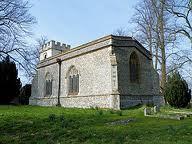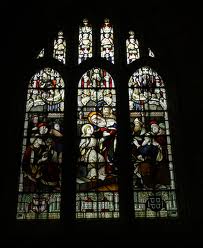
St Michael & All Angels, Horsenden, a Grade II* listed building, stands adjacent to the grounds of Horsenden Manor. There has been a church on this site since at least 1210, although the present church is part of a larger 15th century building.
There were a few subsequent alterations: in 1765, the nave and the west tower were demolished and the present tower built (it contains a bell dated 1582); and in the late 19th century, the chancel was extended 8ft to the east.
Inside, a 16th c screen separates the chancel from the nave, with 14thc patterned tiles, almost certainly made near Penn, on the floor. Either side of the altar there are remarkable Victorian tiles depicting an eagle with the head of a calf and vice versa. The stained glass in the south windows (right), regarded as some of the best of its period (1900), is by Westlake.
Horsenden occupies an very important footnote in history: Edward Stone, Rector from 1737 (and related by marriage to the Grubbe family, see the History page), working on the principle that, as he wrote, 'the general maxim that many natural maladies carry their cures along with them or that their remedies lie not far from their causes,'
discovered, when thoughtfully walking along a river bank one day, that chewing willow bark helped his rheumatism, and reported this landmark discovery to the Royal Society in 1763. The active ingredient was later shown to be salicylic acid or aspirin. Stone, a keen amateur scientist, also wrote scholarly papers on astronomical parallaxes.
He later served in various parishes around Chipping Norton, where a blue plaque has been erected to commemorate his discovery of aspirin, but was, at his own request, buried in Horsenden.
The key–holders are listed on the church notice board. The current Horsenden key-holder is Vicky Peel 01844 342977,
See also The Controversial Story of Aspirin and Philosophical Transactions of the Royal Society 2015.
The Parish Giving Scheme

